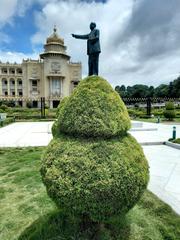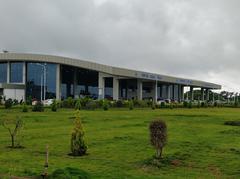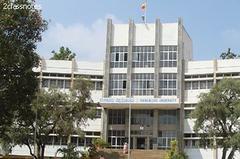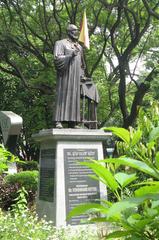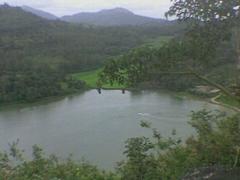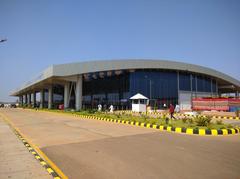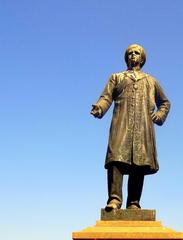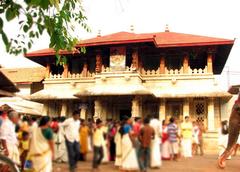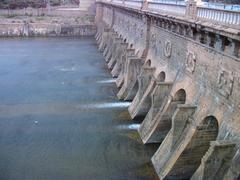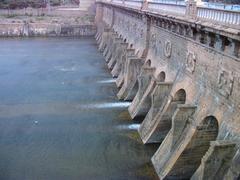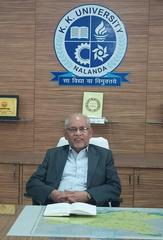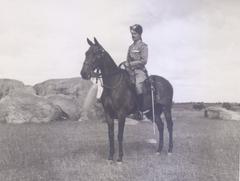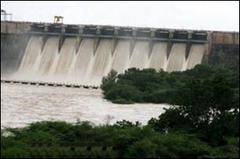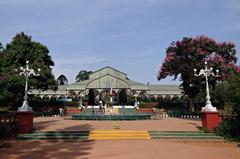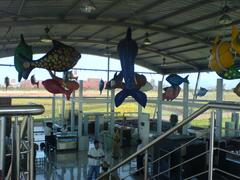Bhimarayanagudi Tourist Guide: Visiting Hours, Tickets, Attractions, and Practical Travel Tips
Date: 04/07/2025
Introduction
Nestled in the northern reaches of Karnataka, Bhimarayanagudi is an under-the-radar destination offering a fascinating blend of historical, cultural, and rural experiences. While not as internationally recognized as Hampi or Badami, Bhimarayanagudi captivates visitors with its spiritual landmarks, agricultural innovation, and authentic village life. Central to its identity is the Bhimaraya (Hanuman) Temple, a spiritual hub drawing pilgrims and cultural enthusiasts. Complemented by the presence of the University of Agricultural Sciences, which has made the town a center for agricultural development and research, Bhimarayanagudi offers a rewarding experience for those seeking to engage with Karnataka’s living heritage.
This comprehensive guide will provide you with detailed information on Bhimarayanagudi’s key attractions—including the temple, fort, and agricultural research station—visiting hours, ticket policies, transportation, accommodations, and nearby historical sites. Practical tips on accessibility, festival timings, and local etiquette are also included to ensure you have a seamless and enriching visit. For real-time updates and personalized trip planning, the Audiala app is highly recommended (Trawell.in, KSRTC, The Wander Therapy).
Contents
- Introduction
- Historical Background and Cultural Significance
- Early Settlement and Dynastic Influence
- Colonial and Post-Independence Developments
- Religious and Cultural Heritage
- Architectural and Artistic Traditions
- Key Attractions and Their Details
- Bhimaraya (Hanuman) Temple
- Bhimarayanagudi Fort
- Agricultural Research Station
- Local Markets and Rural Life
- Festivals and Cultural Events
- Visiting Hours and Ticket Information
- Transportation and Accessibility
- Accommodation Guide
- Nearby Historical Sites and Destinations
- Practical Visitor Tips
- Frequently Asked Questions (FAQs)
- Conclusion and Recommendations
- Sources and Further Reading
Historical Background and Cultural Significance
Early Settlement and Dynastic Influence
The history of Bhimarayanagudi is deeply intertwined with the broader Deccan region. Archaeological findings in the Gulbarga (Kalaburagi) district point to ancient settlements. The area flourished under the Chalukyas (6th–8th centuries CE), renowned for their architectural patronage and promotion of Kannada and Sanskrit literature. The influence of subsequent dynasties, including the Rashtrakutas and Kalyani Chalukyas, further enriched the region’s cultural landscape. The 14th-century Bahmani Sultanate also left its mark, introducing Indo-Islamic architecture and Sufi traditions (Trawell.in, Karmaa Timees).
Colonial and Post-Independence Developments
During the British era, Bhimarayanagudi was part of Hyderabad State under the Nizam. After India’s independence, it became part of Karnataka and witnessed significant agricultural and educational advancements. The establishment of the University of Agricultural Sciences campus marked a turning point, positioning the town as an epicenter for rural development and sustainable agriculture.
Religious and Cultural Heritage
The Bhimaraya (Hanuman) Temple is the spiritual heart of the town. Dedicated to Lord Hanuman (locally revered as Bheemaraya), the temple features modest yet distinctive architecture and serves as a focal point for both daily worship and vibrant festivals, particularly Hanuman Jayanti. The presence of nearby shrines and dargahs underlines the town’s syncretic culture (Trawell.in).
Architectural and Artistic Traditions
While Bhimarayanagudi lacks grand monuments, its temples, homes, and public spaces reflect vernacular architecture—sloping tiled roofs, stone masonry, and decorative woodwork. Folk arts, including Dollu Kunitha (drum dance) and Veeragase (warrior dance), are integral to festivals and community gatherings, often supported by the local university’s cultural initiatives.
Key Attractions and Their Details
Bhimaraya (Hanuman) Temple
- Significance: Ancient shrine dedicated to Lord Hanuman/Bheemaraya. Renowned for its spiritual ambiance and regional architectural style.
- Visiting Hours: Daily from 6:00 AM to 8:00 PM, with special morning and evening aarti ceremonies.
- Entry: Free for all visitors; donations welcome for temple maintenance.
- Events: Major celebrations during Hanuman Jayanti with special pujas, processions, and folk performances.
- Accessibility: Wheelchair-accessible ramps and assistance available.
Bhimarayanagudi Fort
- History: A medieval fort illustrating the region’s strategic importance. Built by local rulers, it features traditional Karnataka architectural elements influenced by the Vijayanagara Empire.
- Visiting Hours: Daily from 9:00 AM to 6:00 PM.
- Tickets: INR 50 for adults, INR 20 for children (5–12 years); guided tours available on-site for INR 300 per group.
- Nearby: Sri Bhimashankar Temple (dedicated to Lord Shiva) and Bhimarayanagudi Lake (ideal for relaxation and birdwatching).
- Festivals: During Mysore Dasara, Gowri Ganesha, and Ugadi, cultural activities are organized in and around the fort (Karnataka.com).
Agricultural Research Station
- Managed by: University of Agricultural Sciences, Raichur.
- Focus: Dryland farming and sustainable agriculture. Educational tours and agri-tourism experiences available.
- Visiting Hours: Monday–Saturday, 9:00 AM–5:00 PM. Prior booking recommended for guided tours.
- Entry: Free.
Local Markets and Rural Life
- Weekly Market: Held on Saturdays, offering local produce, handicrafts, and traditional foods such as jolad rotti and spicy chutneys.
- Experience: Opportunity to interact with farmers and artisans, and observe rural Karnataka’s vibrant lifestyle.
Festivals and Cultural Events
- Hanuman Jayanti: Most significant festival, marked by rituals, music, and community feasts.
- Mysore Dasara: Local processions and performances near the fort.
- Gowri Ganesha and Ugadi: Traditional celebrations with decorated temples and special prayers.
- Harvest Fairs: Organized by the university, blending agricultural demonstrations with folk arts (Safar Mentor).
Visiting Hours and Ticket Information
| Attraction | Visiting Hours | Entry Fee | Notes |
|---|---|---|---|
| Bhimaraya Temple | 6:00 AM – 8:00 PM | Free; donations welcome | Special events during Hanuman Jayanti |
| Bhimarayanagudi Fort | 9:00 AM – 6:00 PM | INR 50 (adults), INR 20 (children) | Guided tours: INR 300 per group |
| Agricultural Research Station | 9:00 AM – 5:00 PM (Mon–Sat) | Free | Prior booking for tours recommended |
Transportation and Accessibility
Road Connectivity
- From Shahpur: 4 km north of Shahpur; accessible by auto-rickshaws, shared tempos, or private taxis.
- From Yadgir: 40 km via state and local roads; buses and taxis available.
- From Kalaburagi (Gulbarga): 90 km; connected by road and rail to major cities. KSRTC buses and private taxis are commonly used (KSRTC).
Rail Connectivity
- Nearest Stations: Shahpur (minor), Yadgir (major, with connections to Bengaluru, Hyderabad, Mumbai).
- From Yadgir: Buses or taxis to Shahpur, then onward to Bhimarayanagudi.
Air Connectivity
- Kalaburagi Airport: 90 km away, with limited flights to Bengaluru and Hyderabad.
- Hyderabad International Airport: 250 km away, offering broader connectivity.
Accessibility for Differently-Abled
- Temple and Fort: Ramps and assistance available at the temple; the fort has uneven terrain—sturdy footwear recommended.
- Public Transport: Limited accessibility features; private vehicles best for those with mobility needs.
Accommodation Guide
In Bhimarayanagudi
- Guesthouses and Lodges: Limited, basic facilities; budget rates under ₹500/night.
- Temple Accommodation: Occasionally available for pilgrims; inquire locally.
In Shahpur (4 km away)
- Budget Hotels/Lodges: Clean, basic amenities (e.g., Shahpur Residency, Sri Krishna Lodge); ₹500–₹1,200/night.
In Yadgir (40 km away)
- Mid-Range Hotels: Air conditioning, attached bathrooms, dining options (e.g., Hotel Mayura, Hotel Surya); ₹1,000–₹2,500/night.
In Kalaburagi (90 km away)
- Wide Options: Ranging from budget to three-star hotels (e.g., Citrus Hotel Gulbarga, Hotel Heritage Inn); ₹1,500–₹4,000/night (The Wander Therapy).
Booking Tips
- Advance booking recommended during festivals or peak travel times.
- Online platforms such as MakeMyTrip, Booking.com, and OYO Rooms are widely used in Kalaburagi.
Nearby Historical Sites and Destinations
- Yadgir (20 km): Yadgir Fort, local markets, eateries.
- Shahapur (30 km): Chandrampalli Dam (picnics, boating, birdwatching).
- Gulbarga (60 km): Gulbarga Fort, Jama Masjid, Khwaja Bande Nawaz dargah.
- Bidar (120 km): Bidar Fort, Persian-influenced monuments, Bidriware crafts.
- Basavakalyan (90 km): Basavakalyan Fort, temples, Basava Jayanti celebrations.
- Hampi (200 km): UNESCO World Heritage site, iconic temple ruins.
- Raichur (100 km): Raichur Fort, ancient temples.
- Bijapur (Vijayapura, 180 km): Gol Gumbaz, Indo-Islamic monuments.
- Badami, Aihole, Pattadakal (200–250 km): Chalukyan-era temples and UNESCO sites.
Practical Visitor Tips
- Best Time to Visit: October–March for pleasant weather; monsoon (June–September) brings lush scenery but can affect road conditions (India Utenica).
- Dress Code: Modest attire recommended, especially in temples.
- Local Etiquette: Seek permission before photographing people; remove footwear before entering shrines.
- Health & Safety: Carry bottled water, insect repellent, basic medicines; medical services in Shahpur, Yadgir, and Kalaburagi.
- Currency: Cash preferred; ATMs in Shahpur and Yadgir.
- Language: Kannada is primary; Hindi and English are understood in tourist areas.
- Connectivity: Mobile networks generally available; signal may vary in rural areas.
Frequently Asked Questions (FAQs)
Q: What are the visiting hours for Bhimarayanagudi’s main attractions?
A: Bhimaraya Temple: 6:00 AM–8:00 PM; Fort: 9:00 AM–6:00 PM; Agricultural Station: 9:00 AM–5:00 PM (Mon–Sat).
Q: Is there an entry fee for the temple or fort?
A: Temple: Free entry (donations welcome); Fort: INR 50 (adults), INR 20 (children).
Q: Are guided tours available?
A: Yes, at the fort (INR 300/group) and agricultural station (advance booking recommended).
Q: How do I reach Bhimarayanagudi?
A: By road from Shahpur (4 km), Yadgir (40 km), or Kalaburagi (90 km); nearest major railway station: Yadgir.
Q: What is the best time to visit?
A: October–March, or during festivals like Hanuman Jayanti for cultural experiences.
Conclusion and Recommendations
Bhimarayanagudi is a compelling destination for travelers interested in history, spirituality, and rural culture. From the tranquil Bhimaraya Temple and the storied fort to vibrant festivals and local markets, the town offers a rich, immersive experience. Its accessibility, affordable accommodation, and proximity to major Karnataka heritage sites make it ideal for both short visits and extended exploration.
For up-to-date information, itinerary planning, and festival schedules, download the Audiala app. Explore further resources on Karnataka’s historical and cultural destinations, and stay connected via our social media channels for the latest tips and stories.
Images to include: Bhimaraya Temple entrance (“Bhimarayanagudi Bhimaraya Temple visiting hours”), local festivals (“Hanuman Jayanti celebrations in Bhimarayanagudi”), fort architecture (“Bhimarayanagudi Fort main entrance”), agricultural research campus (“Agricultural research facilities in Bhimarayanagudi”), and folk art performances (“Dollu Kunitha dance in Bhimarayanagudi”). An interactive map showing Bhimarayanagudi’s location relative to Gulbarga, Yadgir, and major transport links is recommended.
Internal links:
External links:
Sources and Further Reading
- Exploring Bhimarayanagudi: A Guide to Karnataka’s Historical Site, Visiting Hours, Tickets, and Cultural Heritage (Trawell.in)
- Bhimarayanagudi Tourism Guide: Visiting Hours, Attractions & Nearby Karnataka Historical Sites (ClearHolidays)
- Visiting Bhimarayanagudi Fort: History, Hours, Tickets, and Festival Guide (Karnataka.com)
- Exploring Bhimarayanagudi: Visiting the Historic Hanuman (Bheemaraya) Temple – Transportation, Accessibility, and Accommodation Guide (KSRTC)
- The Wander Therapy: Best Places to Visit in Karnataka (The Wander Therapy)
- Karmaa Timees: Karnataka Culture and Festivals (Karmaa Timees)
- India Utenica: Karnataka Travel Guide (India Utenica)
- Karnataka Tourism Official Website (Karnataka Tourism)

